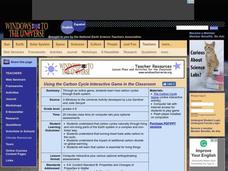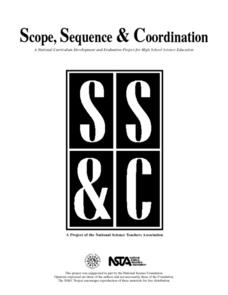Baylor College
Finding the Carbon in Sugar
In session one, demonstrate for your class how a flame eventually goes out when enclosed in a jar in order to teach that oxygen is required for combustion. In session two, class members then burn sugar in a spoon to observe how it...
Curated OER
Using the Carbon Cycle Interactive Game in the Classroom
An online reading and interactive game bring the path of a carbon molecule to life for your earth science explorers! As an assessment, learners can map out or write about their experience in the carbon cycle. Thoroughly written...
Curated OER
Changing Planet: Black Carbon - a Dusty Situation
Introduce your young meteorologists to black carbon produced by the burning of fossil fuels by showing the video, "Changing Planet: Black Carbon." Viewers discover that deposition of this carbon on polar ice impacts the absorption of...
Curated OER
Properties of Useful Carbon Compounds
Nine action-packed organic chemistry exercises are contained in this mini-unit on carbon containing compounds. Examples include constructing models of alkanes, producing aromatic esters, and preparing pigments for paint and dyes....
Curated OER
The Carbon Cycle
Here is an interesting science lesson. Pupils discover that carbon, just like water, is absolutely necessary for all living things to survive. They study how it cycles through nature, become familiar with the periodic table, and look at...
Curated OER
Carbon Atom Mobile
Students research the element of carbon, its composition, and the importance of carbon to life on earth. Then they design model mobiles of carbon atoms to demonstrate their understanding of the configuration of protons, neutrons, and...
Curated OER
Organic Chemistry II Exam 3
In this chemistry worksheet, students determine which compound is the most acidic in each multiple choice question. Then they determine what the major product would be in each of the reactions stated on the sheet.
Curated OER
Allotropes
Brilliant graphics depict a variety of allotropes, especially the allotropes of carbon. Some notes are available to help make these useful for teaching your young chemists, but not for every slide. With some additional preparation on...
Curated OER
Carbon and The Molecular Diversity of Life
Biodiversity begins at the molecular level. When biology pupils complete this activity, they will explore a variety of organic compounds that are necessary for life. Six short-answer questions and a chart of the functional groups are to...
Curated OER
Amazing Carbon
Explore carbon and bonding with this learning exercise. First, class members read a short excerpt about carbon and its characteristics. In response to the reading, they draw an electron dot diagram of carbon as well as diagrams of...
Curated OER
Uses for Elements in the Carbon Family
By providing a quick and informative overview of carbon-related products, this presentation would be useful as an introduction to the topic or as a review. In a concise and easy to understand way, this presentation lists facts about...
Curated OER
Group 14, The Carbon Group
Six slides summarize the details about group 14 in the periodic table, otherwise known as the carbon group. Young chemists will see facts about carbon itself, and then some general uses of related metalloids. This is a short and basic...
Curated OER
Acid-Base Chemistry
In this chemistry worksheet, young scholars write the balanced equations when a significant reaction occurs in each. Then they rank each element in increasing order of acid strength. Students also rank the strengths of each of the listed...
Curated OER
Substitution and Elimination Reactions
In this chemistry worksheet, students complete the reactions by drawing structures of major products, indicating important minor products. They also write the structure of the product and describe the stereo chemistry of the product.
Curated OER
Metals
In this chemistry worksheet, students use the clues at the bottom of the sheet to complete the crossword puzzle on metals. There are 21 clues to solve on the sheet.
Curated OER
Percentage Composition
For this chemistry worksheet, students find the formula weight for each of the substances listed on the sheet. Then they find the percentage composition as indicated.
Curated OER
Quantitative Problems (Mass)
In this chemistry worksheet, young scholars identify how much aluminum and hydrochloric acid is needed to produced a certain amount of hydrogen gas. Then they identify how many grams of oxygen are used.
Curated OER
Chemistry Worksheet (Mole)
In this chemistry worksheet, students identify and name the number of neutrons, electrons, and protons for each. Then they illustrate how the electrons are arranged in a cloud. Students also find the relative number of atoms in the two...
Curated OER
Organic and Biological Compounds
Carbon as a building block for organic compounds is demonstrated by diagrams and facts for its bonding style. Saturated and unstaturated hydrocarbons are detailed and facts about biological compounds such as proteins, nucleic acids,...
Curated OER
Oceanic Absorption- Oceanic Sequestration
Young scholars examine the different techniques that may be used to reduce carbon dioxide in the atmosphere. In this ocean pollution lesson students divide into groups and complete a lab to see how the ocean holds carbon dioxide.
Curated OER
Using the Carbon Cycle Interactive Game in the Classroom
Students play a game. In this carbon cycle lesson, students read The Carbon Cycle, list places where carbon is found on Earth, brainstorm why carbon is important and play an online interactive game.
Curated OER
Integrating Biology: The Elements in Your Body
In this body elements worksheet, students read about the chemical make-up of the human body and answer questions about the elements.
Curated OER
Do Some Research: Coal
In this researching coal instructional activity, students research, write a short report, and draw a picture of coal. Students complete two activities.
Curated OER
Chemistry Chapter 11
In this chemistry worksheet, students name the forces that need to be overcome to reduce samples to individual atoms, such as the diamond. Then they determine which substances exhibit dipole forces. Students also complete a Phase diagram...

























